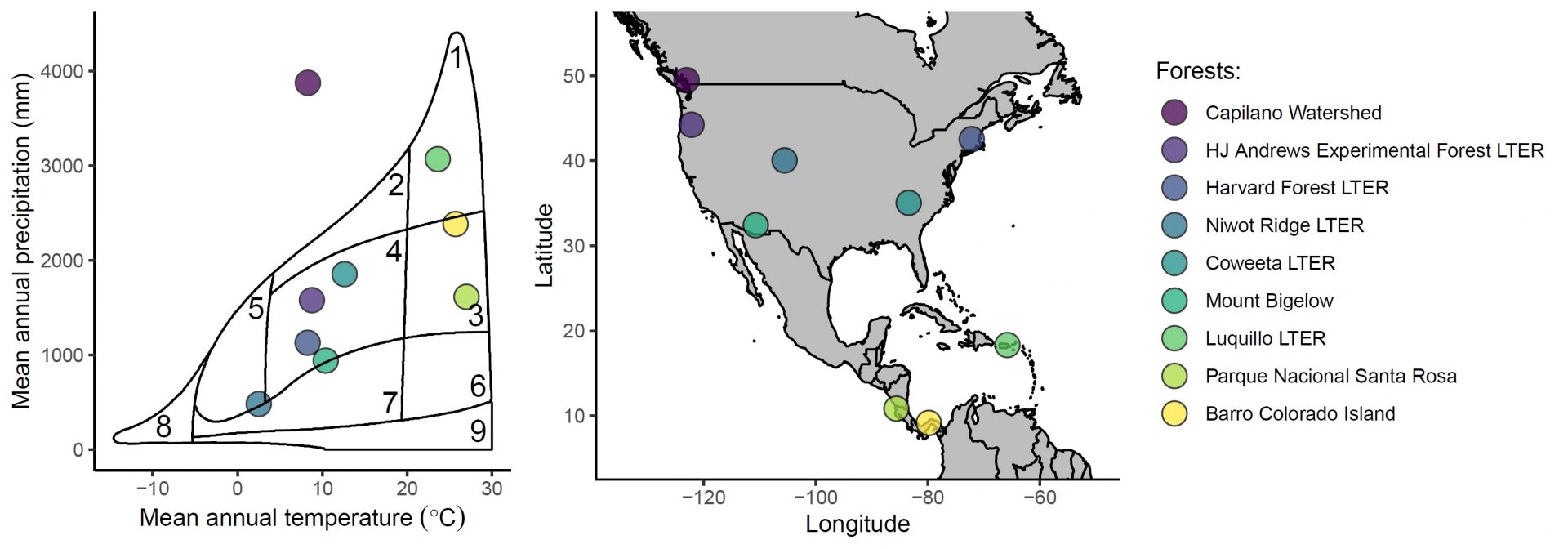The Forest MacroSystems (FMS) network is a macroecological forest monitoring network. The purpose of the FMS network is to generate long-term data sets for global variation in forest diversity, demographics, and dynamics. Importantly, standardized methods are used to collect data across all sites, which helps minimize the error due to methodology differences that is typically found in analyses spanning such broad macroecological gradients of time and space. We are using FMS data to develop and test mechanistic theory for linking variation in the biotic and abiotic environment to variation in plant physiological rates, and how this “scales up” across levels of organization, from cells to the biosphere. We are particularly interested in understanding the drivers of global variation in plant functioning, and predicting how this will change in response to climate change.
Why FMS? The FMS network is a powerful and unique monitoring network designed to assess instantaneous changes in forests due to climate change. Our sampling methodology produces data for annualized diversity, demographics, and dynamics across plant size classes, from the very largest individuals all the way down to the smallest individuals (1 cm stem diameter at ground height). Such data are challenging to collect, especially across such large geographic scales. This makes the FMS network unique among other forest monitoring networks.
The FMS network currently comprises nine sites arrayed across latitude (Figure 1), from tropical seasonal forest in Panama (9° N) to temperate rainforest in British Columbia (50° N). These sites span the global climate space and all major biomes in which terrestrial forests occur (Figure 1, Table 1). The FMS network was established in 2011, and is expanding; anyone interested in installing a site should contact us.
Figure 1: The nine FMS network sites plotted on a map (left) and in Whittaker climate space (right). Biome definitions are from Whittaker (1970). 1, tropical rainforest; 2, temperate rainforest; 3, tropical seasonal forest; 4, temperate forest; 5, taiga; 6, savannah; 7, woodland/shrubland; 8, tundra; 9, desert.

The FMS network grew from an earlier NSF Macrosystems Biology project entitled “Experimental Macroecology: Effects of Temperature on Biodiversity.” This project examined latitudinal diversity in soil microbes, soil invertebrates, and plants. Patterns of biodiversity, such as the increase toward the tropics and the peaked curve during ecological succession, are fundamental phenomena for ecology. Such patterns have multiple, interacting causes, but temperature emerges as a dominant factor across organisms from microbes to trees and mammals, and across terrestrial, marine, and freshwater environments. The purpose of this project is to generate and test theory for how temperature impacts biodiversity through its effect on biochemical processes and metabolic rate. A combination of standardized surveys in the field and controlled experiments in the field and laboratory measure diversity of three taxa – trees, invertebrates, and microbes – and key biogeochemical processes of decomposition in seven forests distributed along a geographic gradient of increasing temperature from cold temperate to warm tropical.
Table 1: Forest MacroSystems site details.
| Name | Code | Biome | Latitude | Longitude | Elevation (m) | Mean annual temperature (°C) | Mean annual precipitation (mm) | 2011 | 2012 | 2013 | 2014 | 2015 | 2016 | 2017 | 2018 | 2019 | 2020 |
|---|---|---|---|---|---|---|---|---|---|---|---|---|---|---|---|---|---|
| HJ Andrews Experimental Forest | AND | Temperate Forest | 44.22936 | -122.15304 | 860 | 8.773487 | 1578.4 | X | X | X | X | X | X | X | x | ||
| Barro Colorado Island | BCI | Tropical seasonal rainforest | 9.156922 | -79.847419 | 157.1548 | 25.71382 | 2383 | X | X | X | X | X | X | ||||
| Capilano Watershed | CAP | Temperate rainforest | 49.47231 | -123.04759 | 550 | 8.3 | 3875.92 | X | X | ||||||||
| Coweeta Hydrologic Laboratory | CWT | Temperate Forest | 35.04679 | -83.433239 | 864 | 12.62168 | 1853.8 | X | X | X | X | X | X | X | X | X | X |
| Harvard Forest | HFR | Temperate Forest | 42.53746 | -72.178653 | 356.4 | 8.268253 | 1128.7 | X | X | X | X | X | X | X | |||
| Luquillo Experimental Forest | LUQ | Tropical rainforest | 18.32302 | -65.817056 | 385.8 | 23.61466 | 3069.2 | X | X | X | X | X | X | X | |||
| Mt. Bigelow | MTB | Temperate Forest | 32.4177 | -110.72887 | 2470 | 10.4 | 940 | x | X | X | X | X | X | X | |||
| Niwot Ridge | NWT | Subalpine forest | 40.03941 | -105.56004 | 3186 | 2.505485 | 481.6 | X | X | X | X | X | X | X | X | ||
| Parque Nacional Santa Rosa | PSR | Tropical dry forest | 10.84297 | -85.612453 | 289 | 27 | 1614 | X | X |
References
Whittaker, R. H. Communities and Ecosystems (Macmillan, 1970).
